Fanning
(Tabuaeran Atoll)

| 11/2/01
We arrived at Fanning Island (Tabuaeran Atoll) 03 deg 51 min North, 159 deg
22 min West on Friday Oct 26. Even though Fanning is east of the
international date line is was officially Saturday Oct 27 there because
Fanning is part of the Republic of Kiribati (pronounced Kir-i-bas) and the
capital of Kiribati, Tarawa, is west of the international date line.
Kiribati is one of the poorest countries in the world and the contrasts with
the atolls of French Polynesisia are quite striking. Kiribati used to be
called the Gilbert Islands and was under British jurisdiction until 1979
when it became independent. The people of Fanning are Melanesians, not
Polynesians, and were resettled from Tarawa. Tarawa has a population
problem and you can emigrate to Fanning and get 1 acre of land and a small
amount of money.
The customs and immigration guys came out on a boat to meet us. (Actually
its "the" boat since the whole island of 1600 people only owns one 25 foot
aluminum equipment transport boat, a few outboard powered canoes and a bunch
of sailing canoes). We had to fill out quite a lot of paperwork but the
folks were very friendly and spoke reasonable English. The immigration guy,
Tabuya, who was also the police chief, invited us to a picnic with his
family the next day on the other side of the atoll.
The biggest news to happen to Fanning in many years is the "NCL project"
which stands for Norwegian Cruise Lines. One of their cruise ships comes
once every week and there are some of their American and Australian
employees here supervising the construction of several buildings so that the
passengers can be served during a day long stop. Its only a few huts
serving as kitchen and bar and a bunch of picnic tables but it's a very big
deal for a place where the only source of economic income is seaweed
farming. Talking to the Australian running the operation, Rick, gives you
an idea of the frustration involved in constructing something in a place
where the only source of supply is a broken down ship that comes every month
or so, if that.
There is also an American, Leif, who lives on a boat Mystic with his wife
and 4 kids. He, along with another American Nate, have a small business
ashore that employs half a dozen locals making coconut wood lamps for
export. He has a nice woodworking facility but also is suffering from the
lack of supplies and spare parts. He has just finished getting the permits
for a shrimp aquaculture facility that he hopes to startup soon. He is
planning on
expanding to other islands. After being fully operational, he estimates his
company's
profits at ~$12m US a year. Which brings up the interesting situation for
him of taxes. His
plan is to not pay any, including US. While we wish him luck on the tax
scheme, we don't think he'll
manage to escape. He used to have a small company that did software for the
business re-engineering trade and is quite familiar with the all of the
trials and tribulations that we
went through at Epiphany. But he likes low-tech better now.
All of the westerners (about 8) on the island showed up at the police
chief's picnic on Saturday. Also in attendance was the headmaster of th
local secondary school and his wife, a teacher there, and their kids.
We ate traditional Kiribati food such as fried breadfruit and fish and
drank coconut juice from nuts right off of the tree The musical
entertainment was boom box with a mixture of local music along with
a lot of disco tunes.
The next day we went into the village and ran into the mayor who invited us
to a town gathering that night. We baked up a bunch of chocolate chip
cookies and brought 1000 yds of 100-lb fishing line for gifts. We were
served a simply enormous amount of local food including shrimp that looked
like something out of Alien. I had to make a speech about where we were
from and presented the fishing line to the village. Ruth was also asked to
speak about the war in Afghanistan and fielded questions for 15 minutes.
Even though English is spoken we did this through an interpreter because a
lot of the older folks don't speak English very well. There was about a 40
minute dance and singing exhibition that was quite different than
Polynesian dance. The dancing has a much slower rhythm and the singing is
very high pitched and nasal, a little like the Austral Islands. It was very
cool. Then they turned on the disco, and several of the locals asked us to
dance.
It was a lot of fun and very interesting.
The next few days we did a bunch of scuba diving outside of the atoll pass.
The abundance of marine life was striking. We were engulfed by huge schools
of bright blue and yellow fish. There were half a dozen large sea turtles
in evidence. And there were a lot of larger fish, such as 5-foot long Hump
head Morai Wrasses (Napoleon fish). Interestingly enough there were no
sharks in evidence although there are certainly sharks around. Ruth lost a
large tuna to a shark while fishing. (She just got the head). The coral
was quite nice and included a bunch of pink coral, a color of coral not seen
in French Polynesia. The water was a little cloudy, maybe 30-40 foot
visibility, but, overall, the diving rates very highly.
On Thursday the 2nd we took a dinghy trip to the north-west side of the
atoll where there is an old transpacific submarine cable station and an
overgrown, abandoned airstrip. We beached the dinghy in front of the
village hall/church of the village near the cable station and were greeted
by the minister. He directed us to the cable station that was about a mile
walk north. We walked through the village and ended up getting invited by a
family for drinks (coconuts). Their house was one of the nicer family
"compounds" built on their acre and included a taro pit for raising the
large starchy plant that forms an important part of the diet. There were
several huts for the 3 generations that formed the family - father and
mother, daughter and her three brothers and three sisters, and the
daughter's husband and
son. No electricity, refrigeration or running water. But quite a nice
shady setting with no significant bugs and a nice cool breeze. They opened
coconuts for us and the daughter, who spoke English well, asked us lots of
questions about where we lived, where we were going etc.. She also had her
kids sing us some songs and we reciprocated by singing Puff the Magic
Dragon. We coincidentally had a nice metal soup ladle in our backpack and
gave it to them as a gift. They offered us some pumpkins but it was obvious
that this was a significant part of their food supply and we declined. One
of the attached pictures shows the mother preparing taro. Another shows the
grandkid and his uncles and aunts.
Afterwards, we walked on to the old cable station. It has been abandoned
for a long time but part of it has been converted to the only highschool on
the island. The concrete buildings with tile roofs are a contrast with the
thatched huts on the rest of the island.
Near the beach by the cable station, above the old pier where the cable
used to go out to sea I buried the Epiphany time capsule that I have been
carrying on our entire trip. There is a web site dedicated to "geo-caches"
which contains a database of items and their GPS coordinates and we will add
this location to the site. Our friend Boris at Epiphany buried a similar
Epiphany time capsule in Croatia this summer. The capsule contains a CD
with the original software release as well as some other Epiphany
memorabilia. The coordinates of the geo-cache are 03 54.541 N 159 23.442 W
which is under some scrub bushes about 10 feet above the storm high tidc
level.
Our friends Chris and Marcus from Pez Vela are underway from Christmas
Island, about 160 nm away and will be here on Friday, just after dawn. We
are looking forward to meeting up with them again and doing some diving.
I'm sure that Chris, who did her master's thesis on abalone aquaculture will
be interested in talking with the folks here who are planning the shrimp
farm.
The final attachment is a view of the atoll pass from Bravo Charlie at
sunset. We are planning on leaving out this pass on Monday for Hawaii. It
should take us 7 days to get there. Hopefully there won't be any more late
season hurricanes to contend with. Currently there is Hurricane Octave,
halfway between Mexico and Hawaii which formed, quite unusually, at the
very end of October.
|
| At the police chief's picnic, playing a card
game with very changable rules with his daughters |
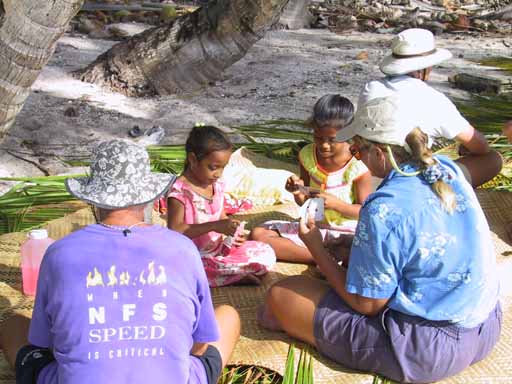 |
| At the village meeting. The school principal,
on the left, hosted us. |
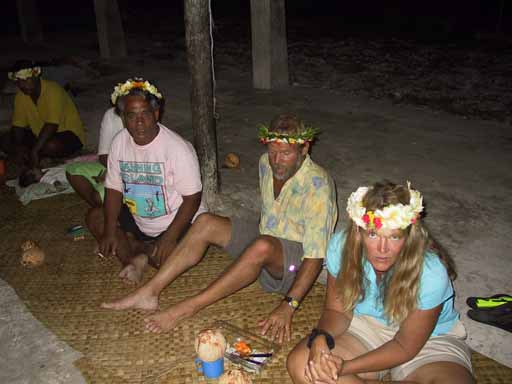 |
| A grey trevally we caught fishing in the pass
from the dinghy. We decided not to eat it as
the ciguatera test was weakly positive |
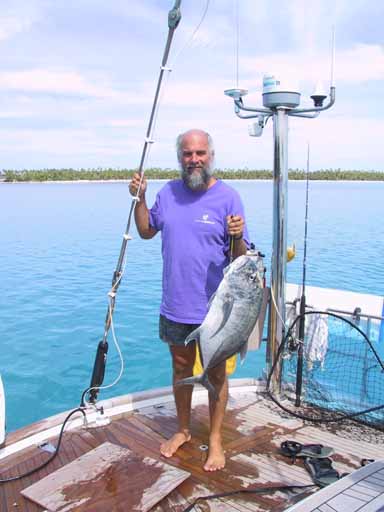 |
| We were invited by a family to stop and visit
on our walk to the cable station |
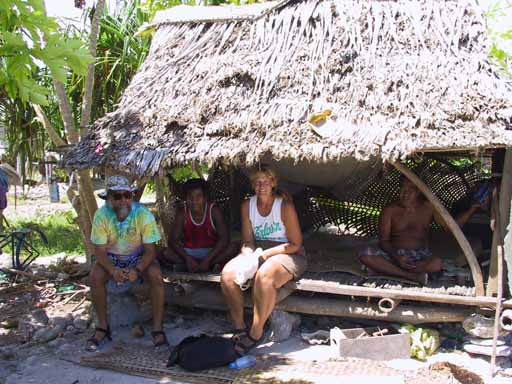 |
| The kids sang for us - then we sang Puff the
Magic Dragon for them |
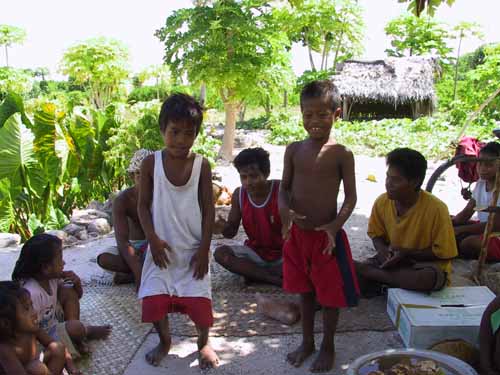 |
| Mother preparing tarot |
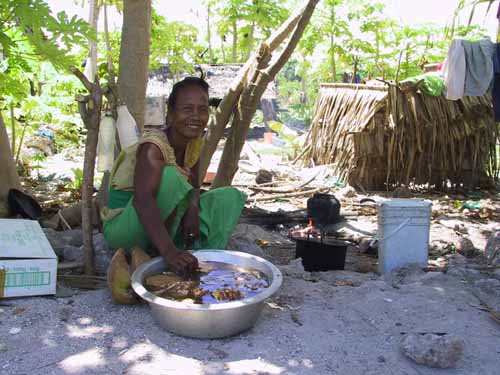 |
| The ruins of the old transpacific cable -
picture taken from where we buried the E.piphany Clarity 3.0 CD geocache! |
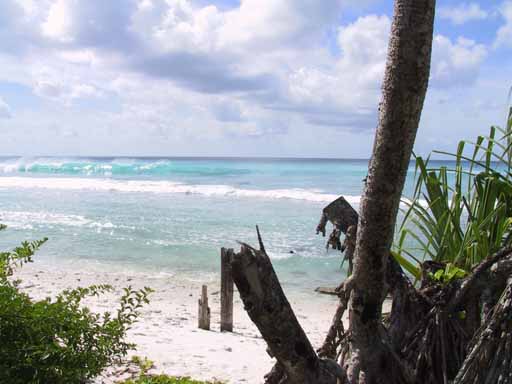 |
| Looking northwest through the (one and only)
pass from our anchorage off of the village pier |
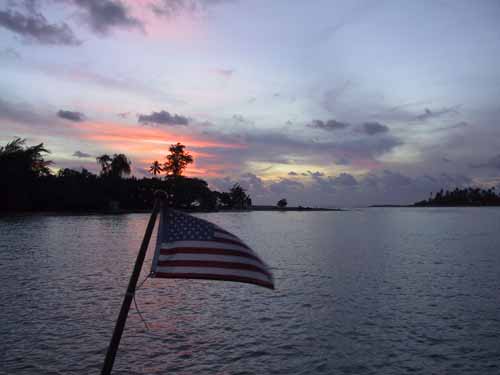 |
Revised: April 19, 2003.
|
![]()